Today Current Affairs: 17th August 2021 for UPSC IAS exams, State PSC exams, SSC CGL, State SSC, RRB, Railways, Banking Exam & IBPS, etc
Table of Contents
Data On Fatalities Caused Due To Hydro-Meteorological Calamities:
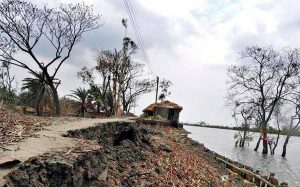
The Union Home Ministry has released data on fatalities caused due to hydro-meteorological calamities.
- Hydro-meteorological calamities and hazards include flash floods, cloudburst and landslides
Highlights:
- Nearly 6,800 people lost their lives in the country over the past three years due to hydro-meteorological calamities.
- West Bengal has recorded the highest deaths among all States.
- The causes for these calamities include extreme rainfall events or cloudbursts.
- These types of fatal landslip events are common almost every year, mainly in the Himalayan States, in the Western Ghats, and Konkan areas.
- In terms of funds released by the Centre under State Disaster Response Funds, highest funds were allocated to Maharashtra.
- Over the past three years, West Bengal had braved four tropical cyclones — Fani (May 2019), Bulbul (November 2019), Amphan (May 2020) and Yaas (May 2021).
- Under the Disaster Management Act, States were empowered to take action to prevent deaths due to natural calamities.
National Hydrogen Mission:
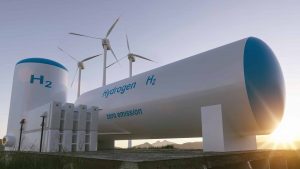
The launch of the National Hydrogen Mission was announced by PM Modi. The aim is to make India a global hub for the production and export of green hydrogen.
- The proposal for the National Hydrogen Mission was made in the Budget 2021 to launch NHM that would enable the generation of hydrogen “from green power sources”.
- Hydrogen is the lightest and first element on the periodic table. Since the weight of hydrogen is less than air, it rises in the atmosphere and is therefore rarely found in its pure form, H2.
- At standard temperature and pressure, hydrogen is a nontoxic, nonmetallic, odorless, tasteless, colorless, and highly combustible diatomic gas.
- Hydrogen fuel is a zero-emission fuel burned with oxygen. It can be used in fuel cells or internal combustion engines. It is also used as a fuel for spacecraft propulsion.
- Hydrogen can be stored physically as either a gas or a liquid.
- Storage of hydrogen as a gas typically requires high-pressure tanks.
- Storage of hydrogen as a liquid requires cryogenic temperatures because the boiling point of hydrogen at one atmosphere pressure is −252.8°C.
- Hydrogen can also be stored on the surfaces of solids (by adsorption) or within solids (by absorption).
Van Dhan Programme:
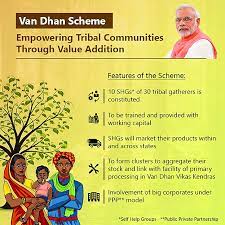
The Ministry of Tribal Affairs has planned to set up 200 ‘Van Dhan’ producer companies in all the 27 states in the next five years with priority to the Aspirational Districts under the Van Dhan programme.
- Aspirational Districts are those districts in India that are affected by poor socio-economic indicators. The Transformation of Aspirational Districts’ Programme (TADP) is being anchored by the NITI Aayog at the central level.
Van Dhan Programme:
- It is a market-linked tribal entrepreneurship development program for forming clusters of tribal Self Help Groups (SHGs) and strengthening them into Tribal Producer Companies.
- The initiative targets livelihood generation for tribals by harnessing the wealth of forest i.e. Van Dhan.
- Launch: The scheme was launched in 2018 as Pradhan Manti Van Dhan Yojana (PMVDY).
- Implementation: It is being implemented by the Tribal Cooperative Marketing Development Federation of India Limited (TRIFED).
- Aims:
- To tap into traditional knowledge & skill sets of tribals by adding technology & IT to upgrade it at each stage and to convert the tribal wisdom into a viable economic activity.
- To promote and leverage the collective strength of tribals to achieve a viable scale to take on the predatory market forces in the areas where these are still prevalent.
- Proposition is to set-up tribal community-owned Minor Forest Produce (MFP)-centric multi-purpose Van Dhan Vikas Kendras in predominantly tribal districts.
2nd Phase Of The SAMVAD Programme:

The Ministry of Women and Child Development has launched the 2nd phase of the SAMVAD programme. The second phase was launched on the completion of one year of programme.
- The programme is aimed at mental health outreach for children who are abandoned and orphaned, child survivors of trafficking, or in conflict with law.
- Earlier, the government had announced a special “PM-CARES for Children” scheme for all those orphaned due to Covid-19.
- Stands for: Support, Advocacy & Mental health interventions for children in Vulnerable circumstances and Distress (SAMVAD).
- Funded By: The initiative is funded by the Ministry of Women and Child Development.
- Implementing Body: It is led by the National Institute of Mental Health and Neuro Sciences (NIMHANS).
- The NIMHANS is the apex centre of mental health and neuroscience education. It operates autonomously under the Ministry of Health and Family Welfare.
- Recently, on the request of the Ministry of Home Affairs, NIMHANS, issued a set of guidelines on the management of mental health issues of the prisoners and prison staff.
- Purpose: It is a national initiative and integrated resource that works in child protection, mental health and psychosocial care of children in difficult circumstances.
- It encompasses a specialized training curriculum on childhood trauma, interventions for children in conflict with the law, forensics in child and adolescent psychiatry and mental health.
- Education and mental health support to children with special needs, protection and care in the context of adoption.
- The initiative is providing coping mechanisms for children in distress by training close to 1 lakh stakeholders comprising Child Protection Functionaries, tele-counsellors, educators, law professionals among others.
- Integration with Local Bodies: The initiative aims to foster care and integration of child protection and mental health in the Panchayati Raj systems in aspirational districts across the country to facilitate awareness generation and improve service delivery at the grassroot level.
IBSA:
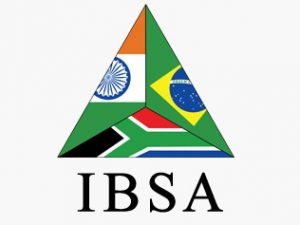
India organized the IBSA (India, Brazil and South Africa) Tourism Ministers’ virtual meeting.
- India is the current IBSA Chair.
- The IBSA is a trilateral, developmental initiative between India, Brazil and South Africa to promote South-South cooperation and exchange.
- The idea of South-South Cooperation (SSC) is not new. Its genesis can be traced back to the decades of efforts by countries and groupings working together to ensure South-South solidarity such as Bandung conference 1955, Non-Aligned Movement 1961, G77 grouping, UNCTAD, the Buenos Aires Plan of Action 1978, and the 2009 Nairobi declaration.
- The grouping was formalized and named the IBSA Dialogue Forum when the Foreign Ministers of the three countries met in Brasilia (Brazil) on 6th June 2003 and issued the Brasilia Declaration.
- Headquarters: IBSA does not have a headquarters or a permanent executive secretariat.
- At the highest level, it counts on the Summits of Heads of State and Government.
- So far Five IBSA Leadership Summits have been held. The 5th IBSA Summit was held in Pretoria (South Africa) in 2011. The 6th IBSA Summit is to be hosted by India.
- IBSAMAR (IBSA Maritime Exercise) is an important part of IBSA trilateral defence cooperation.
- Six editions of IBSAMAR have been held so far, the latest one being off the coast of South Africa in October, 2018.
Fortification Of Rice:
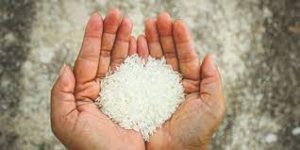
Emphasising that malnutrition is a “hurdle” in the development of women and children, Prime Minister Narendra Modi announced fortification of rice distributed under various government schemes including Public Distribution System (PDS) and Mid-Day-Meal scheme by 2024.
- The Food Safety and Standards Authority of India (FSSAI) defines the fortification as “deliberately increasing the content of essential micronutrients in a food so as to improve the nutritional quality of food and to provide public health benefit with minimal risk to health.”
- According to the FSSAI norms, 1 kg fortified rice shall contain iron (28mg-42.5mg), folic acid (75-125 microgram) and Vitamin B-12 (0.75-1.25 microgram).
- In addition, rice may also be fortified with micronutrients, singly or in combination, at the level– zinc(10mg-15mg), Vitamin A (500-750 microgram RE), Vitamin B1 (1mg-1.5mg), Vitamin B2 (1.25mg-1.75mg), Vitamin B3 (12.5mg-20mg) and Vitamin B6 (1.5mg-2.5mg) per Kg.
- The Ministry of Consumer Affairs, Food and Public Distribution had launched a centrally sponsored pilot scheme on “Fortification of Rice and its Distribution under Public Distribution System (PDS)” for a period of three years beginning 2019-20 with a total budget outlay of Rs.174.64 crore.
- The pilot scheme focuses on 15 districts in 15 states.
- Under the scheme, the blending of rice is done at the milling stage. According to the Ministry, Maharashtra and Gujarat have started distribution of fortified rice under PDS in the Pilot Scheme from February, 2020.
- The Scheme is funded by the Government of India in the ratio of 90:10 in respect of North Eastern, hilly and island states and 75:25 in respect of the rest.
Vande Bharat And PM Gati Shakti Master Plan:
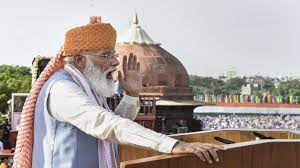
Prime Minister Narendra Modi announced that 75 ‘Vande Bharat’ trains will connect different parts of the country in 75 weeks to mark the ongoing ‘Azadi ka Amrit Mahotsav’.
- Vande Bharat— the indigenous semi-high speed train set — is being given a boost, with the Railways gearing to roll out at least 10 of them, linking around 40 cities, by August 2022 to commemorate 75 years of Independence.
- Hyderabad-based engineering firm, Medha, which in February secured the contract to supply the electrical systems for 44 Vande Bharat trains, has now been told to advance its production plan, so that at least two prototypes can be rolled out by next March following all trials.
On India’s 75th Independence Day, Prime Minister Narendra Modi announced that the Centre will launch ‘PM Gati Shakti Master Plan’, a Rs. 100 lakh-crore project for developing ‘holistic infrastructure’.
- In his speech, PM Modi pegged the project as a source of employment opportunities for the youth in future.
- The Gati Shakti plan will help raise the global profile of local manufacturers and help them compete with their counterparts worldwide. It also raises possibilities of new future economic zones.
The ‘Incel’ Movement:

The ‘incel’ movement, a dangerous online subculture comprising men who identify as ‘involuntary celibates’ and regularly express deeply misogynistic views about women, is slowly becoming a threat to law and order, experts have warned.
- Incels are a largely online community of men who describe themselves as “involuntary celibates. Men who are part of this movement harbour a deep resentment towards both women and other men who are sexually active.
- The blame women for their own lack of sexual and social status. While views tend to vary, some believe that sex is their right — something that is owed to them by virtue of them being males.
- An extreme section of Incels even advocate violence against women.
- The ‘black pill’ theory, often associated with incels, promotes the defeatist idea that your fate is sealed at birth and no matter what changes you try to make, your sexual capital cannot be altered
- ‘Red pillers’, on the other hand, believe the world is biased toward women, and see feminism as female supremacy. They believe there is a systemic bias in favour of women.




